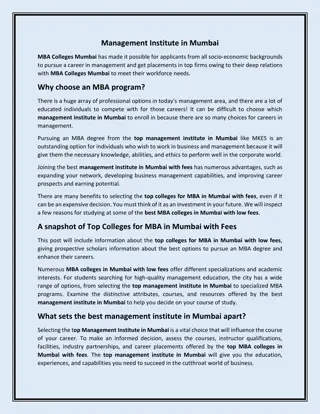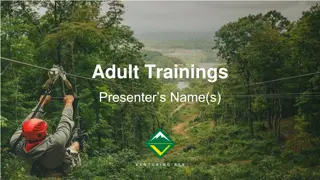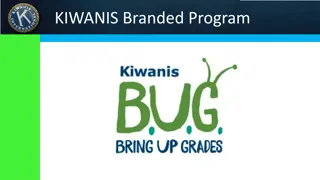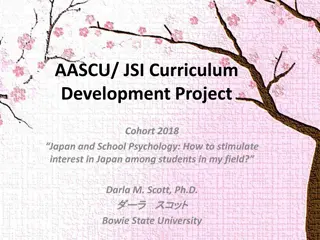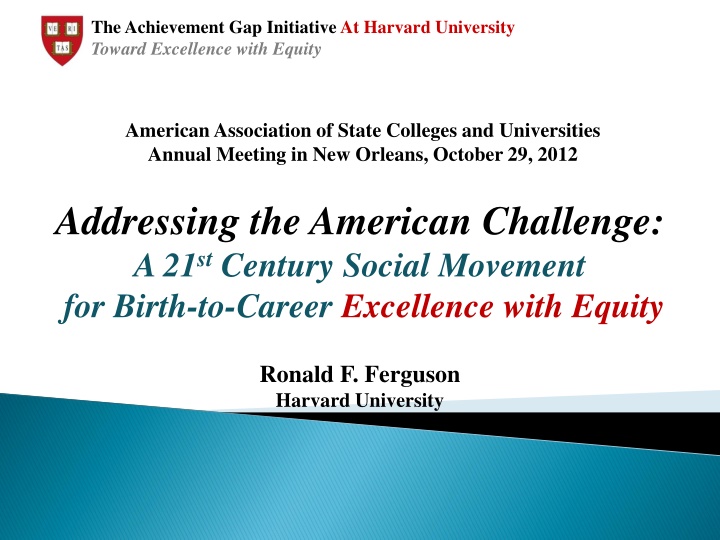
Achieving Excellence with Equity: Addressing Education Disparities
Explore the initiatives and urgency toward achieving excellence with equity in education, addressing high school completion rates and skills gaps among diverse student groups. Learn how exemplary schools pave the way for progress and why there is a call for a social movement toward birth-to-career excellence with equity.
Download Presentation

Please find below an Image/Link to download the presentation.
The content on the website is provided AS IS for your information and personal use only. It may not be sold, licensed, or shared on other websites without obtaining consent from the author. If you encounter any issues during the download, it is possible that the publisher has removed the file from their server.
You are allowed to download the files provided on this website for personal or commercial use, subject to the condition that they are used lawfully. All files are the property of their respective owners.
The content on the website is provided AS IS for your information and personal use only. It may not be sold, licensed, or shared on other websites without obtaining consent from the author.
E N D
Presentation Transcript
The Achievement Gap Initiative At Harvard University Toward Excellence with Equity American Association of State Colleges and Universities Annual Meeting in New Orleans, October 29, 2012 Addressing the American Challenge: A 21st Century Social Movement for Birth-to-Career Excellence with Equity Ronald F. Ferguson Harvard University
Its a Sputnik moment. Communities are going to rise or fall depending upon whether they have a workforce. We need to stop having meetings and have a movement. Bill Shore, GlaxoSmithKline Director of U.S. Community Partnerships North Carolina Chamber of Commerce Education Summit, July 2011
Excellence with Equity is Possible! Few if any group differences among one-year olds it appears groups start from the same place as infants Racial IQ gaps are smaller than in the past. NAEP trends for 17-year olds showed dramatic gap narrowing between 1970 and 1990, showing that rapid progress is possible. NAEP trends for 9-year olds show movement toward group-proportional equality (i.e., all rising but lowest groups rising faster) Exemplary schools and colleges are showing the way.
Why Such Urgency to achieve Excellence with Equity?
Percentage Non-Hispanic White in the United States Age Distribution in 2009. 8485 8584 8482 84 82 80 8078 80 80 78 78 7877 77 75 75 72 72 69 69 65 65 61 61 60 61 6159 5960 5958 59 58 55 55 52 52 Source: U.S. Bureau of the Census http://www.census.gov/popest/estimates.php
STAGNANT HIGH SCHOOL COMPLETION RATES: The US has failed to substantially increase high school graduation rates (versus GED s) over the past half century. And, many other nations have been moving past us. LAGGING SKILLS: Standardized test scores among African American and Latino 17-year olds, on average, equal the scores of white and Asian Americans who are between three and four years younger. At the same time, even white teens in the U.S. score lower in math problem solving than teens in a dozen other nations.
Program for International Student Assessment, 15 Math Problem Solving Program for International Student Assessment, 15- -Year Olds, 2003, Math Problem Solving in OECD Nations Year Olds, 2003, (Red = U.S. Students) in OECD Nations (Red = U.S. Students) 600 500 400 300 200 100 0
Employment of workers with a Bachelors degree or better grew at a 2 percent to 3 percent rate over the past two decades. 4 3.3 3.2 3.2 3 2.5 2 1.9 1.7 2 1.4 1990-1995 0.8 0.6 1 1995-2000 0.2 0 2000-2005 -0.1 -0.2 2005-2010 -1 2010-2012 -1.4 -2 -2.1 -3 High School or Less Some College or Associates Degree Bachelors Degree or More Source: Anthony Carnevale, Tamara Jaysundera and Ban Cheah, 2012. The College Advantage: Weathering the Economic Storm. Georgetown University Center on Education and the Workforce.
Good News: Fall 2010 enrollment (millions) in postsecondary degree- granting institutions exceeded projected enrollment by 12 percent 25 20 15 10 5 0 1995 1996 1997 1998 1999 2000 2001 2002 2003 2004 2005 2006 2007 2008 2009 2010 Source: Anthony Carnevale, Tamara Jaysundera and Ban Cheah, 2012. The College Advantage: Weathering the Economic Storm. Georgetown University Center on Education and the Workforce.
Bad News: Only about 50% of students who start complete a four-year degree in six years and rates vary dramatically by the selectivity of institution Why? 100% SIX-YEAR GRADUATION RATES 90% 80% 75% 70% Overall 60% 53% 52% Very Selective 50% Moderately Selective 37% 40% Minimally Selective 30% 20% 10% 0% Note: Graduation rates are based on freshmen who enroll in the fall of a specified year, who have never attended college before, who attend full-time when they begin and who intend to complete a degree. On average 71% of admitted freshmen fell into this category. Selectivity scale is based on Carnegie Classifications, which is based on number of applicants, number of students admitted, ACT and SAT scores, whether test scores were required, and whether the school was open admissions Source: NCES - IPEDS, Placing Graduation Rates in Context (2006), Table 6
Falling behind other nations college graduation rates Over a single decade, the U.S. fell from 2nd to 15th in college completion rates. 70 2005 1995 60 Decline of the relative position of the US from 1995 to 2005 15 50 2 40 30 20 10 0 Spain Finland Japan Norway Slovenia Greece Iceland UK Slovak Rep Poland Denmark OECD Avg New Zealand Italy Austria Germany Turkey Israel Portugal Australia Sweden EU19 Avg Czech Rep Ireland Switzerland Hungary Netherlands United States Source: Schleicher (2007) based on OECD data. Percentage of tertiary type A graduates to the population at the typical age of graduation.
We need high quality nurturance from birth-to-career. Whose responsibility is it to see the big picture and help lead a movement to achieve it? How about college and university presidents and chancellors?
Key Elements of a Regional System Powerful Leadership that Proclaims, Supports and Sustains a Strong Mandate Chairs and Top Executive Officers from: Major Businesses, Leading Civic Organizations, Colleges and Universities, State and Local Government Officials, Philanthropies Private or Quasi-Public Intermediary Organization(s) as Major Engines Tasks: map the system to identify gaps, document, track and monitor performance for support and accountability, elicit youth perspectives, maintain a youth registry, . . . Front Line Organizations that work with Young People Elementary and middle schools High Schools Community & Four-Year Colleges Independent Training Programs Training Programs in Firms Post-Secondary Outcomes for Young Adults
KEY RESEARCH-BASED ROLES for: Parents Teachers Peers Employers Community Parents Parents Teachers (PreK Teachers (PreK- -18) 18) Community Community Peers Peers Employers Employers
1. 2. Authoritative Parenting and Learning-Focused Home Life Effective Home- School Linkages Parents
Skills among young children, by age and parents education level. Average scores around age 4 (relative to those with grad-school parents) Average scores around age 1 (relative to those with grad-school parents) Average scores around age 2 (relative to those with grad-school parents) 1 1 1 0.9 0.9 0.9 0.8 0.8 0.8 0.7 0.7 0.7 0.6 0.6 0.6 0.5 0.5 0.5 0.4 0.4 0.4 0.3 0.3 0.3 0.2 0.2 0.2 0.1 0.1 0.1 0 0 0 Average early reading scale score Expessive vocabulary (telling stories score) Average math scale score Color Explores objects Explores purposefully Jabbers expressively knowledge Any graduate education Bachelor's degree Source: Calculations using the federal Early Childhood Longitudinal Study, Birth Cohort. Some college/vocational High school completion Less than high school
Research-Based Messages for Early Parenting: Maximize love, minimize stress beginning at birth Talk, sing and use gestures to communicate with infants to accelerate comprehension and language development Use number games and rhythm with toddlers to build foundations for numeracy Enable and encourage spatial awareness by providing opportunities to crawl in cluttered spaces and handle 3-dimensional objects Discuss what you read and see, don t just read. Mix higher- and lower-order discussion: remember, explain and anticipate. We need to saturate communities workplaces, schools, media with this type of advice.
Parenting Styles with School-Aged Kids High Structure & Demandingness Authoritarian Authoritative Low Warmth & Responsiveness High Warmth & Responsiveness Neglectful Permissive Low Structure & Demandingness
3. Methods and Routines for Observing and Refining Teaching , including through use of Student Feedback Teachers (at every level) 4. Methods and Routines for Team-Based Review of Student Work to Understand and Respond to Student Thinking
What is quality teaching and why does it matter? The Tripod 7Cs and MET
STUDENT ACHIEVEMENT OUTCOMES Student Engagement The Tripod 7C s (What Teachers Do) Teacher Professional Learning (PLCs) Content Knowledge The Tripod Pedagogic Skill Relationship-Building Skills
The Seven Cs What Teachers Do (What Students Experience) 1. Caring about students (Encouragement and Emotional Support) S U P P O R T 2. Captivating students (Learning seems Interesting and Relevant 3. Conferring with students (Students Sense their Ideas are Respected) 4. Clarifying lessons (Success Seems Feasible) 5. Consolidating knowledge (Ideas get Connected and Integrated) P R E S S 6. Challenging students (Press for Effort, Perseverance and Rigor) 7. Controlling behavior (Culture of Cooperation and Peer Support) Which is the strongest predictor of value added test score gains?
Color Schemes for Two Secondary Schools School One: Ranked 7th out of 49 that had at least 100 respondents (N=356 students) Control Challenge Care Confer Captivate Consolidate Clarify RowMean 1 1 1 1 1 1 1 1 1 1 1 2 1 1 2 1 2 2 1 1 1 2 2 1 2 2 2 1 2 2 3 1 4 2 1 2 4 2 3 3 2 4 4 4 1 5 5 3 5 5 4 4 5 5 5 5 School Two: Ranked 48th out of 49 that had at least 100 respondents (N=354 students) 4 4 1 1 4 5 1 1 4 1 4 4 5 2 3 1 5 2 4 3 3 3 2 3 5 3 3 2 5 5 1 4 5 4 2 4 5 5 3 5 5 4 4 4 5 5 5 5 Numbers and colors indicate quintiles in the North Carolina secondary school distribution. A B C D E F G H I J K L M N 1 1 1 2 1 2 2 2 3 3 4 4 4 5 1 1 1 1 2 2 2 2 2 2 4 5 4 4 1 1 1 1 1 2 2 2 3 2 4 5 4 4 1.0 1.0 1.1 1.3 1.4 1.7 1.9 2.0 2.4 2.7 3.7 4.0 4.3 4.7 A B C D E F G H I J K L 1 1 2 3 3 3 2 2 3 4 5 3 2 3 1 3 2 4 4 3 3 5 5 5 1 2 1 2 2 4 3 3 4 4 5 4 2.0 2.4 2.4 2.7 3.0 3.1 3.1 3.3 3.6 4.4 4.6 4.6
Some findings from the Gates Foundation Measures of Effective Teaching Project
Predicted differences in months of learning for classrooms at the 25th versus the 75th percentile positions of the composite Seven C s distribution for the MET sample Using student survey responses in one section to predict learning gains in another. Predicted difference per school year* On state math tests 4.8 months On the Balanced Assessment in Math 3.7 months On state English Language Arts (ELA) tests 2.3 months On the Stanford 9 Open Ended ELA 2.9 months *Based on Table 9, p. 26: Bill and Melinda Gates Foundation, Learning about Teaching: Initial findings from the Measures of Effective Teaching Project. December 2010.
Peers 5. Overcoming Pluralistic Ignorance by launching a broad- based Conspiracy to Succeed 6. More Cooperative Learning Norms inside and outside of classrooms i.e., collective rejection of peer dynamics that undermine academic and life success; collective behaviors don t reflect collective values when students misread one another's values and hide their own in order to fit in. Because high achievers are sometimes intellectual bullies.
X2 X1
X2 Point A X1
X2 Point A = Success! X1
Employers 8. Participation in designing and implementing school- to-career systems. 7. Orientations to the World of Work and Possible Selves; Grades 5-16
10. Places to Connect and Belong and Contribute Community 9. Programmatic Supports for Families, Children and Youth
M o v e m e n t G o a l s Strategies Policies Programs Not just about policy! Projects Principles Practices
Authoritative Parenting and Learning-Focused Home Life 1. 2. Home-School Linkages Methods and Routines for Observing and Refining Teaching 3. Parents 10. Places to Connect and Belong Goals Strategies Policies Programs Practices Principles Teachers Community Goals Strategies Policies Programs Practices Principles Goals Strategies Policies Programs Practices Principles Methods and Routines for Team- Based Review of Student Work 4. Program Supports for Families, Children and Youth Peers Employers 9. Goals Strategies Policies Programs Practices Principles Goals Strategies Policies Programs Practices Principles Jobs for parents and apprenticeships for youth Peer Culture Norms: e.g., Conspiracy to Succeed 8. 5. Orientations to the World of Work and Possible Selves Exposures Cooperative Learning Norms inside and outside of classrooms 7. 6.
Any fool can count the seeds in an apple, but only God can count the apples in a seed. Rev. Dr. Robert Schuller The bounty of the harvest depends upon the effectiveness of cultivation, and the effectiveness of cultivation depends, over time, on the intensity of the search for effective methods and the dedication of effort to help children reach their potential.



